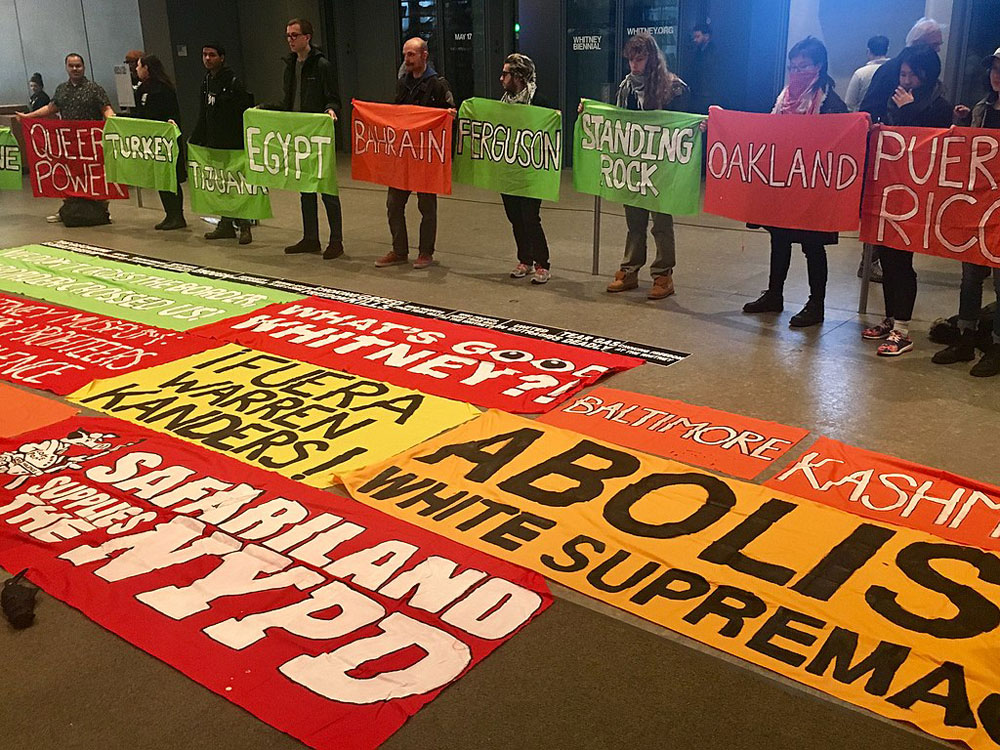
July 20, 2019; Hyperallergic
The Whitney Museum in New York has tried for months to carry on and operate as though things were normal, but courageous artists and activists have not allowed it. They say they will not permit museum directors to sidestep what they view as war crime complicity. Over the past couple of weeks, eight artists have withdrawn from the Whitney Biennial show, citing uncomfortableness with the presence of Warren Kanders on the museum’s board.
NPQ has covered the protests at the Whitney that began in early spring 2019, but to recap: Warren Kanders is the CEO of a company called Safariland. They manufacture what are known as “non-lethal weapons”—things like tear gas and rubber bullets. Safariland’s products are known to have been used on protestors in Ferguson, Baltimore, and Standing Rock, plus migrants at the border in San Ysidro, and most recently, the people marching in Puerto Rico. When Hyperallergic uncovered evidence that Kanders was profiting from violence against protestors and specifically communities of color, activists began demanding that Kanders be removed from the Whitney board. In the spring, the group Decolonize This Place led nine weeks of action in the museum to emphasize this demand.
Michael Rakowitz was the first artist to pull his work, back in March. Korakrit Arunanondchai, Meriem Bennani, Nicole Eisenman, and Nicholas Galanin withdrew last Friday, July 19th. Seeing that, Eddie Arroyo, Agustina Woodgate, and Christine Sun Kim also asked for their work to be removed. Arroyo told Hyperallergic’s Zachary Small his decision was “in solidarity with the artists who have already asked for their artwork to be removed.”
The letter sent by Arunanondchai, Bennani, Eisenman, and Galanin explained that since they were well into show prep by the time details about Kanders’ company emerged, they originally decided to participate. However, “the Museum’s continued failure to respond in any meaningful way to growing pressure from artists and activists has made our participation untenable.”
Sign up for our free newsletters
Subscribe to NPQ's newsletters to have our top stories delivered directly to your inbox.
By signing up, you agree to our privacy policy and terms of use, and to receive messages from NPQ and our partners.
The museum’s response, or lack thereof, is a disturbing part of this story that’s hard to report on because it’s so nonexistent. Employees sent a letter to museum leadership in March, saying they felt compromised and “sickened” to learn that they worked for an institution complicit in violent suppression of democratic movements. Whitney’s director, Adam Weinberg, essentially gave a non-response; he neither defended Kanders nor agreed to remove him, saying only that it wasn’t the museum’s role to “right all the ills of an unjust world,” sidestepping the obvious opportunity to right this particular ill. Kanders himself declared, “I am not the problem.”
A statement by Hannah Black, Ciarán Finlayson, and Tobi Haslett in Artforum this week went into lengthy discussion of art and the art industry’s role in public discourse and the disturbing way that “the art world imagines itself as a limited sphere.” The statement is lengthy and eloquent and bears reading in full, but declares that knowledge of Kanders’ involvement with attacks on protestors “should have been enough to drive the artists in this year’s Whitney Biennial to make the most unequivocal gesture of opposition to Warren B. Kanders: withdrawal from the show. There should have been a boycott.” The statement notes the Whitney Biennial’s role as a “chokepoint” of visibility and distribution, which, said the authors, makes the event a site of leverage for artists asked to participate.
Decolonize This Place hasn’t abandoned the issue, either. After their last week of protests in May, they wrote, “We offer the museum leadership a final window to do the right thing: remove Kanders and participate in the formation of a process with stakeholders: staff, community groups, scholars, artists, and more. Fall is the deadline. We will be back if necessary, and our tactics will escalate further. In the meantime, we expect others will act and organize.”
As for the artists who’ve withdrawn from the Biennial, they aren’t a majority of the presenters, but many hope others will join. Nicholas Galanin originally agreed to participate in the Biennial because he felt that, as a Native American, it was important for him and his work to be visible. But ultimately, he said, pulling his work was “a really easy decision.”—Erin Rubin













